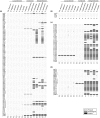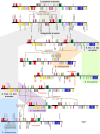Lycophyte plastid genomics: extreme variation in GC, gene and intron content and multiple inversions between a direct and inverted orientation of the rRNA repeat
- PMID: 30556907
- PMCID: PMC6590440
- DOI: 10.1111/nph.15650
Lycophyte plastid genomics: extreme variation in GC, gene and intron content and multiple inversions between a direct and inverted orientation of the rRNA repeat
Abstract
Lycophytes are a key group for understanding vascular plant evolution. Lycophyte plastomes are highly distinct, indicating a dynamic evolutionary history, but detailed evaluation is hindered by the limited availability of sequences. Eight diverse plastomes were sequenced to assess variation in structure and functional content across lycophytes. Lycopodiaceae plastomes have remained largely unchanged compared with the common ancestor of land plants, whereas plastome evolution in Isoetes and especially Selaginella is highly dynamic. Selaginella plastomes have the highest GC content and fewest genes and introns of any photosynthetic land plant. Uniquely, the canonical inverted repeat was converted into a direct repeat (DR) via large-scale inversion in some Selaginella species. Ancestral reconstruction identified additional putative transitions between an inverted and DR orientation in Selaginella and Isoetes plastomes. A DR orientation does not disrupt the activity of copy-dependent repair to suppress substitution rates within repeats. Lycophyte plastomes include the most archaic examples among vascular plants and the most reconfigured among land plants. These evolutionary trends correlate with the mitochondrial genome, suggesting shared underlying mechanisms. Copy-dependent repair for DR-localized genes indicates that recombination and gene conversion are not inhibited by the DR orientation. Gene relocation in lycophyte plastomes occurs via overlapping inversions rather than transposase/recombinase-mediated processes.
Keywords: Isoetes (quillworts); Lycopodiaceae (clubmosses); Lycopodiophyta (lycophytes); Selaginella (spikemosses); evolutionary stasis; gene loss; inversion; plastid genome (plastome).
© 2018 The Authors. New Phytologist © 2018 New Phytologist Trust.
Figures





Similar articles
-
The Unique Evolutionary Trajectory and Dynamic Conformations of DR and IR/DR-Coexisting Plastomes of the Early Vascular Plant Selaginellaceae (Lycophyte).Genome Biol Evol. 2019 Apr 1;11(4):1258-1274. doi: 10.1093/gbe/evz073. Genome Biol Evol. 2019. PMID: 30937434 Free PMC article.
-
Plastid Genomes of the Early Vascular Plant Genus Selaginella Have Unusual Direct Repeat Structures and Drastically Reduced Gene Numbers.Int J Mol Sci. 2021 Jan 11;22(2):641. doi: 10.3390/ijms22020641. Int J Mol Sci. 2021. PMID: 33440692 Free PMC article.
-
Plastome structure, evolution, and phylogeny of Selaginella.Mol Phylogenet Evol. 2022 Apr;169:107410. doi: 10.1016/j.ympev.2022.107410. Epub 2022 Jan 11. Mol Phylogenet Evol. 2022. PMID: 35031459
-
Directed Repeats Co-occur with Few Short-Dispersed Repeats in Plastid Genome of a Spikemoss, Selaginella vardei (Selaginellaceae, Lycopodiopsida).BMC Genomics. 2019 Jun 11;20(1):484. doi: 10.1186/s12864-019-5843-6. BMC Genomics. 2019. PMID: 31185895 Free PMC article.
-
Early "Rootprints" of Plant Terrestrialization: Selaginella Root Development Sheds Light on Root Evolution in Vascular Plants.Front Plant Sci. 2021 Sep 4;12:735514. doi: 10.3389/fpls.2021.735514. eCollection 2021. Front Plant Sci. 2021. PMID: 34671375 Free PMC article.
Cited by
-
The Origin and Evolution of Plastid Genome Downsizing in Southern Hemispheric Cypresses (Cupressaceae).Front Plant Sci. 2020 Jun 23;11:901. doi: 10.3389/fpls.2020.00901. eCollection 2020. Front Plant Sci. 2020. PMID: 32655606 Free PMC article.
-
Phylogenomic data resolved the deep relationships of Gymnogynoideae (Selaginellaceae).Front Plant Sci. 2024 Jul 16;15:1405253. doi: 10.3389/fpls.2024.1405253. eCollection 2024. Front Plant Sci. 2024. PMID: 39081519 Free PMC article.
-
Unparalleled Variation in RNA Editing among Selaginella Plastomes.Plant Physiol. 2020 Jan;182(1):12-14. doi: 10.1104/pp.19.00904. Epub 2019 Sep 3. Plant Physiol. 2020. PMID: 31481629 Free PMC article.
-
The First Plastid Genome of the Holoparasitic Genus Prosopanche (Hydnoraceae).Plants (Basel). 2020 Mar 1;9(3):306. doi: 10.3390/plants9030306. Plants (Basel). 2020. PMID: 32121567 Free PMC article.
-
The complete chloroplast genome of the medical plant Huperzia crispata from the Huperziaceae family: structure, comparative analysis, and phylogenetic relationships.Mol Biol Rep. 2022 Dec;49(12):11729-11741. doi: 10.1007/s11033-022-07979-w. Epub 2022 Oct 5. Mol Biol Rep. 2022. PMID: 36197623
References
Publication types
MeSH terms
Substances
Associated data
- Actions
- Actions
- Actions
- Actions
- Actions
- Actions
- Actions
- Actions
- Actions
- Actions
- Actions
- Actions
- Actions
- Actions
- Actions
- Actions
Grants and funding
LinkOut - more resources
Full Text Sources
Miscellaneous

